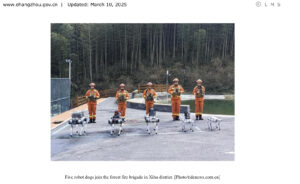Robot Dogs in Firefighting: China Ushers in a New Era for Emergency Response

*Photo from eHangzhou.gov.
The adoption of robot dogs by China’s fire services represents a major leap in integrating advanced robotics with public safety. Powered by developers like Unitree Robotics and DEEP Robotics, these four-legged machines are being deployed in wildfire response, hazardous sites, and emergency rescues—supporting firefighters on the frontlines.
In this article, we explore what robot dogs are, where they’ve been deployed in China, how they operate, their benefits, limitations, and the broader impact on future emergency response.
What are the firefighting robot dogs?
Robot dogs are quadruped robots equipped with thermal cameras, LiDAR, gas sensors, and high-capacity water or foam cannons. Chinese firms like Unitree and DEEP Robotics have tailored these robots for fire rescue, enabling them to enter dangerous environments and execute tasks humans cannot.
Where are they already in use?
- Qingdao, Shandong: Two robot dogs with 15 km range and 3.6-hour endurance have joined the city fire brigade to detect hazards and stream live data.
- Changsha, Hunan: The DEEP Robotics X30 model was deployed in February, capable of operating in temperatures from –20 °C to 55 °C, carrying up to 85 kg over 10 km ranges.
- Hangzhou & others: Participating in forest patrols with smoke sensors and thermal imaging to spot early-stage wildfires.
How do the robot dogs fight fires?
These robot dogs are outfitted with specialized firefighting gear:
- Water and foam cannon: Sprays up to 60 m with a flow of 40 L/s and adjustable angles between 5°–85° for versatile deployment.
- Blower function: Creates airflow paths in wildfires to disperse heat and smoke.
- Sensors: Thermal cameras, LiDAR, gas detection, and real-time video streaming enable remote scene assessment.
- Agile movement: Capable of climbing stairs, traversing rubble, and navigating collapsed structures even in low visibility.
Benefits for firefighters
Integrating robot dogs into rescue operations offers clear advantages:
- Enhanced safety—robots can scout high-risk zones before humans
- Improved efficiency—continuous firefighting with water cannons
- Live data feeds—teams can monitor situations remotely
- Superior mobility—robots reach areas too dangerous for people
Challenges and limitations
Despite their capabilities, robot dogs face some constraints:
- Extreme heat: Electronic systems struggle beyond 500 °C—but developers are enhancing thermal shielding.
- Battery life: Around 3.6 hours of operation per charge, requiring logistical planning for battery swaps.
- Cost: High initial investment limits widespread deployment.
- Connectivity: Reliable real-time control depends on robust network coverage, often lacking in remote disaster zones.
Geopolitical and technological context
The deployment of robot dogs underscores China’s strategic push to lead in robotics for public safety. Backed by massive government funding and national policies, the country has become a global powerhouse in quadruped robots.
Bringing these robots into civilian services like firefighting introduces a new standard for emergency response—and sparks international dialogue around ethics, regulation, and automation in crisis management.
Frequently Asked Questions
- What are robot dogs?
Autonomous quadruped robots equipped with firefighting tools and sensors. - Are they being used now?
Yes—deployed in places like Qingdao and Changsha since early 2025. - Can they replace firefighters?
No—they act as advanced support tools, not replacements. - Do they work autonomously?
They operate autonomously and remotely, especially in unsafe or inaccessible zones.
Conclusion
Robot dogs represent a transformative leap in firefighting technology—providing mobility, intelligence, and resilience when lives are at stake. While challenges remain, their real-world deployment demonstrates the feasibility and promise of robot-assisted emergency responses.
The next question is not if—but when—they will support firefighters globally.
Impressed by this new rescue tech?
Subscribe to our newsletter for exclusive insights on emergency robotics, AI in public safety, and the next-gen tools keeping us safe.



